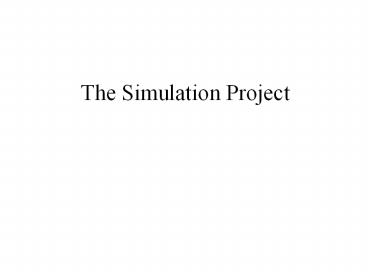The Simulation Project - PowerPoint PPT Presentation
Title:
The Simulation Project
Description:
The Simulation Project Simulation ... a model use System knowledge Engineering judgement Model ... Queueing WIP storage needs Staffing requirements ... – PowerPoint PPT presentation
Number of Views:612
Avg rating:3.0/5.0
Title: The Simulation Project
1
The Simulation Project
2
Simulation Project Steps
- a.- Problem Definition
- b.- Statement of Objectives
- c.- Model Formulation and Planning
- d.- Model Development and Data Collection
- e.- Verification
- f.- Validation
- g.-Experimentation
- h.- Analysis of Results
- i.- Reporting and Implementation
3
Basic Principles of Modeling
- To conceptualize a model use
- System knowledge
- Engineering judgement
- Model-building tools
- Remodel as needed
- Regard modeling as an evolutionary process
4
Manufacturing Systems Simulation
5
Manufacturing Systems
- Material Flow Systems
- Assembly lines and Transfer lines
- Flow shops and Job shops
- Flexible Manufacturing Systems and Group
Technology - Supporting Components
- Setup and sequencing
- Handling systems
- Warehousing
6
Characteristics ofManufacturing Systems
- Physical layout
- Labor
- Equipment
- Maintenance
- Work centers
- Product
- Production Schedules
- Production Control
- Supplies
- Storage
- Packing and Shipping
7
Modeling Material Handling Systems
- Up to 85 of the time of an item on the
manufacturing floor is spent in material
handling. - Subsystems
- Conveyors
- Transporters
- Storage Systems
8
Goals and Performance Measures
- Some relevant questions
- How a new/modified system will work?
- Will throughput be met?
- What is the response time?
- How resilient is the system?
- How is congestion resolved?
- What staffing is required?
- What is the system capacity?
9
Goals of Manufacturing Modeling
- Manufacturing Systems
- Identify problem areas
- Quantify system performance
- Supporting Systems
- Effects of changes in order profiles
- Truck/trailer queueing
- Effectiveness of materials handling
- Recovery from surges
10
Performance Measuresin Manufacturing Modeling
- Throughput under average and peak loads
- Utilization of resources, labor and machines
- Bottlenecks
- Queueing
- WIP storage needs
- Staffing requirements
- Effectiveness of scheduling and control
11
Some Key Modeling Issues
- Alternatives for Modeling Downtimes and Failures
- Ignore them
- Do not model directly but adjust processing time
accordingly - Use constant values for failure and repair times
- Use statistical distributions
12
Key Modeling Issues -contd
- Time to failure
- By wall clock time
- By busy time
- By number of cycles
- By number of widgets
- Time to repair
- As a pure time delay
- As wait time for a resource
13
Key Modeling Issues -contd
- What to do with an item in the machine when
machine downtime occurs? - Scrap
- Rework
- Resume processing after downtime
- Complete processing before downtime
14
Example
- Single server resource with processing time
exponential (mean 7.5 minutes) - Interarrival time also exponential (mean 10
minutes) - Time to failure, exponential (mean100 min)
- Repair time, exponential (mean 50 min)
15
Example 5.1 -contd
- Queue lengths for various cases
- Breakdowns ignored
- Service time increased to 8 min
- Everything random
- Random processing, deterministic breakdowns
- Everything deterministic
- Deterministic processing, random breakdowns
16
Trace Driven Models
- Models driven by actual historical data
- Examples
- Actual orders for a sample of days
- Actual product mix, quantities and sequencing
- Actual time to failure and downtimes
- Actual truck arrival times
17
A sampler of manufacturing models from WSC98
- Automotive
- Final assembly conveyor systems
- Mercedes-Benz AAV Production Facility
- Machine controls for frame turnover system
18
A sampler of manufacturing models from WSC98
-contd
- Assembly
- Operational capacity planning daily labor
assignment in a customer-driven line at Ericsson - Optimal design of a final engine drop assembly
station - Worker simulation
19
A sampler of manufacturing models from WSC98
-contd
- Scheduling
- Batch loading and scheduling in heat treat
furnace operations - Schedule evaluation in coffee manufacture
- Manufacturing cell design
20
A sampler of manufacturing models from WSC98
-contd
- Semiconductor Manufacturing
- Generic models of automated material handling
systems at PRI Automation - Cycle time reduction schemes at Siemens
- Bottleneck analysis and theory of constraints at
Advanced Micro Devices - Work in process evolution after a breakdown
- Targeted cycle time reduction and capital
planning process at Seagate
21
A sampler of manufacturing models from WSC98
-contd
- Semiconductor Manufacturing - contd
- Local modeling of trouble spots in a Siemens
production facility - Validation and verification in a photolithography
process model at Cirent - Environmental issues in filament winding
composite manufacture - Order sequencing
22
A sampler of manufacturing models from WSC98
-contd
- Materials Handling
- Controlled conveyor network with merging
configuration at Seagate - Warehouse design at Intel
- Transfer from warehouse to packing with Rapistan
control system - Optimization of maintenance policies
23
Manufacturing Simulators
- ProModel
- Witness
- Taylor II
- AutoMod
- Arena
- ModSim and Simprocess
- SimSource
- Deneb
- Valisys (Tecnomatix)
- Open Virtual Factory
- EON
- Simul8































